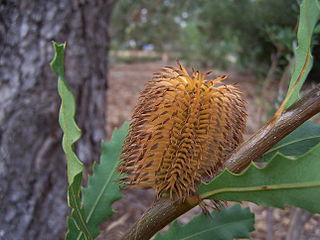
Banksia quercifolia, commonly known as the oak-leaved banksia, is a species of shrub that is endemic to the southwestern coast of Western Australia. It has smooth, greenish bark, wavy, wedge-shaped, serrated leaves, yellow, orange or brown flowers in cylindrical spikes, followed by broadly linear follicles surrounded by the remains of the flowers.
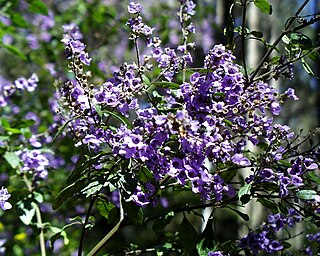
Prostanthera melissifolia, commonly known as balm mint bush, is a species of flowering plant in the family Lamiaceae and is endemic to south-eastern Australia. It is an erect shrub with hairy branches, egg-shaped leaves with fine teeth on the edges and mauve to purple or pink flowers on the ends of branchlets.
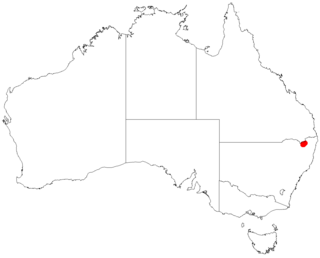
Prostanthera staurophylla, commonly known as Tenterfield mint-bush, is a species of flowering plant in the family Lamiaceae and is endemic to a small area on the New England Tableland of New South Wales. It is an erect to spreading, strongly aromatic shrub with hairy branches, deeply lobed leaves and bluish-mauve flowers with darker markings.

Seringia integrifolia, commonly known as common firebush, is a species of flowering plant in the family Malvaceae and endemic to the south-west of Western Australia. It is a small, much-branched shrub, its young growth densely covered with woolly, white or rust-coloured hairs. The leaves are oblong, 8.5–17 mm (0.33–0.67 in) long, more or less glabrous on the upper surface and densely covered with woolly white hairs on the lower surface. The flowers are arranged in small, loose groups with thin, egg-shaped bracts that fall off as the flowers open. The sepal lobes are broad, pointed, mostly 6.5–8.5 mm (0.26–0.33 in) long and the ovary has 5 carpels with about 4 ovules in each. The fruit is a spherical, softly hairy capsule.

Eremophila drummondii, commonly known as Drummond's eremophila, is a flowering plant in the figwort family, Scrophulariaceae and is endemic to the south-west of Western Australia. It is a variable shrub, usually with sticky branches and leaves, long, thin leaves and mauve or purple flowers in spring.

Grevillea patentiloba is a species of flowering plant in the family Proteaceae and is endemic to the south-west of Western Australia. It is a prostrate to erect, spreading to straggling shrub with divided leaves, and down-turned clusters of red to deep pink and cream-coloured to bright yellow flowers with a red to deep pink style.

Commersonia hermanniifolia, commonly known as wrinkled kerrawang, is a species of flowering plant in the family Malvaceae and is endemic to New South Wales. It is a prostrate or trailing shrub with oblong to lance-shaped leaves that are paler on the lower surface, and flowers with five white sepals fading to pink and five pinkish petals.
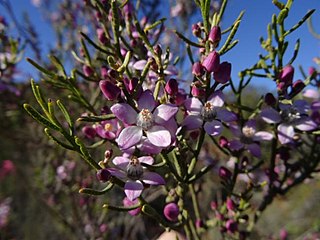
Philotheca brucei is a species of flowering plant in the family Rutaceae and is endemic to Western Australia. It is a shrub with cylindrical leaves grooved along the top and in spring, white to pink or mauve flowers with five egg-shaped petals.

Prostanthera canaliculata is a species of flowering plant in the family Lamiaceae and is endemic to the south-west of Western Australia. It is a small, erect shrub with hairy branchlets, narrow egg-shaped to narrow elliptical leaves and pale blue or pale violet to white flowers with no markings.

Prostanthera eckersleyana, commonly known as crinkly mintbush, is a species of flowering plant in the family Lamiaceae and is endemic to the south-west of Western Australia. It is an erect or spreading shrub with sticky, hairy branchlets, egg-shaped to elliptical leaves and blue, mauve to purple or violet flowers with maroon spots inside the petal tube.
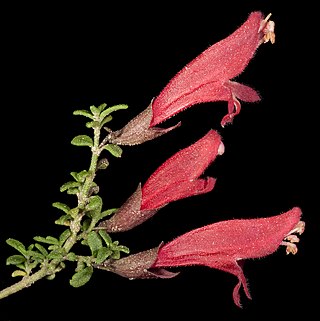
Prostanthera grylloana is a species of flowering plant in the family Lamiaceae and is endemic to Western Australia. It is a small, erect shrub with densely hairy branchlets, small, spatula-shaped leaves and red to pink flowers.

Commersonia craurophylla, commonly known as brittle leaved rulingia, is a species of flowering plant in the family Malvaceae and endemic to southern continental Australia. It is a dense, spreading shrub with crinkled, narrowly oblong to linear leaves, and white to cream-coloured flowers.
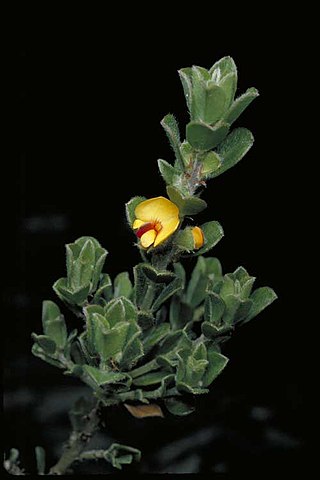
Pultenaea heterochila is a species of flowering plant in the family Fabaceae and is endemic to the south of Western Australia. It is an erect, low-lying or prostrate shrub with hairy leaves and yellow and red flowers.

Bossiaea neoanglica is a species of flowering plant in the family Fabaceae and is endemic to eastern Australia. It is a prostrate to low-lying shrub with sparsely hairy foliage, egg-shaped to more or less round leaves, and yellow and red flowers.

Seringia exastia, also known as fringed fire-bush, is a species of flowering plant in the mallow family and is endemic to northern Western Australia. It is an erect, compact shrub with hairy young branches, narrowly egg-shaped, elliptic or oblong leaves and purple flowers arranged in groups of 7 to 9.

Lasiopetalum parvuliflorum is a species of flowering plant in the family Malvaceae and is endemic to the south-west of Western Australia. It is an erect, spreading shrub with hairy stems, oblong to linear leaves and green or cream-coloured flowers.

Commersonia magniflora is a species of flowering plant in the family Malvaceae and endemic to Australia. It is an erect shrub with wrinkled, narrowly oblong to elliptic or egg-shaped leaves, and deep pink flowers.

Androcalva crispa, commonly known as crisped leaf commersonia, is a species of flowering plant in the family Malvaceae and is endemic to the south-west of Western Australia. It is a prostrate shrub that forms suckers from rhizomes and has densely new growth, clusters of lobed, egg-shaped or oblong leaves with wavy, serrated edges, and groups of white and pinkish-purple flowers.

Guichenotia angustifolia is a species of flowering plant in the family Malvaceae and is endemic to the south-west of Western Australia. It is an erect, prostrate or climbing shrub with hairy young growth, hairy, oblong to linear leaves and pink to mauve flowers.

Seringia cacaobrunnea, commonly known as chocolate fire-bush, is a species of flowering plant in the family Malvaceae and is endemic to the south-west of Western Australia. It is a bushy shrub with hairy new growth, oblong to elliptic leaves and purple flowers in groups of 3 to 11.





















